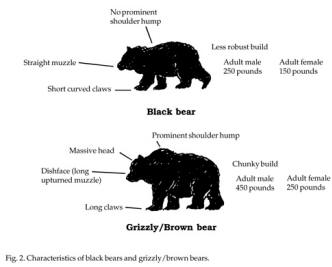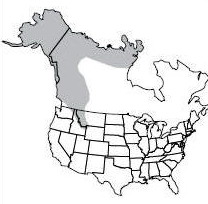Black bears typically are nocturnal, although occasionally they are active during the day. In the South, black bears tend to be active year-round; but in northern areas, black bears undergo a period of semihibernation during winter. Bears spend this period of dormancy in dens, such as hollow logs, windfalls, brush piles, caves, and holes dug into the ground. Bears in northern areas may remain in their dens for 5 to 7 months, foregoing food, water, and elimination. Most cubs are born between late December and early February, while the female is still denning.
Black bears breed during the summer months, usually in late June or early July. Males travel extensively in search of receptive females. Both sexes are promiscuous. Fighting occurs between rival males as well as between males and unreceptive females. Dominant females may suppress the breeding activities of subordinate females. After mating, the fertilized egg does not implant immediately, but remains unattached in the uterus until fall. Females in good condition will usually produce 2 or 3 cubs that weigh 7 to 12 ounces (198 to 340 g) at birth.
After giving birth, the sow may continue her winter sleep while the cubs are awake and nursing. Lactating females do not come into estrus, so females generally breed only every other year. Parental care is solely the female’s responsibility. Males will kill and eat cubs if they have the opportunity. Cubs are weaned in late summer but usually remain close to the female throughout their first year. This social unit breaks up when the female comes into her next estrus. After the breeding season, the female and her yearlings may travel together for a few weeks. Black bears become sexually mature at approximately 3 1/2 years of age, but some females may not breed until their fourth year or later.
In North America, black bear densities range from 0.3 to 3.4 bears per square mile (0.1 to 1.3 bears/km2). Densities are highest in the Pacific Northwest because of the high diversity of habitats and long foraging season. The home range of black bears is dependent on the type and quality of the habitat and the sex and age of the bear. In mountainous regions, bears encounter a variety of habitats by moving up or down in elevation. Where the terrain is flatter, bears typically range more widely in search of food, water, cover, and space. Most adult females have well-defined home ranges that vary from 6 to 19 square miles (15 to 50 km2). Ranges of adult males are usually several times larger.
Black bears are powerful animals that have few natural enemies. Despite their strength and dominant position, they are remarkably tolerant of humans. Interactions between people and black bears are usually benign. When surprised or protecting cubs, a black bear will threaten the intruder by laying back its ears, uttering a series of huffs, chopping its jaws, and stamping its feet. This may be followed by a charge, but in most instances it is only a bluff, as the bear will advance only a few yards (m) before stopping. There are very few cases where a black bear has charged and attacked a human. Usually people are unaware that bears are even in the vicinity. Most bears will avoid people, except bears that have learned to associate food with people. Food conditioning occurs most often at garbage dumps, campgrounds, and sites where people regularly feed bears. Habituated, food-conditioned bears pose the greatest threat to humans (Herrero 1985, Kolenosky and Strathearn 1987).

